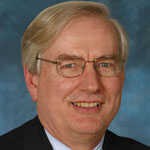Amid the daily, dire news emanating from Japan, the world watches as its citizens try their best to cope with life in the post-earthquake, post-tsunami country. Thankfully, those two tragic events are over, but a third tragedy, the ongoing nuclear disaster, won’t be over any time soon.
Now new fears are emerging about food and water safety — a fundamental need for a country with hundreds of thousands suffering refugees already without the most basic resources.

Royal
These fears are partly the result of not understanding what is really occurring within the nuclear power facilities.
To help clarify the increasingly confusing situation, two Washington University scientists and experts in nuclear science and radiation, Henry Royal, MD, professor of radiology at the School of Medicine, and Lee Sobotka, PhD, professor of chemistry in Arts & Sciences, will offer their expertise in an Assembly Series lecture at 4 p.m. Friday, April 1, in Lab Science Room 300 on the Danforth Campus.
The lecture, “Fukushima: The Science and Health Effects of the Nuclear Disaster in Japan,” is free and open to the public.
Sobotka
Sobotka and Royal’s presentation will focus on the scientific and technical aspects behind the volatile situations in the four buildings housing the damaged reactors. Sobotka, an expert in basic nuclear science, will delve into reactor physics, isotope production and the chemistry behind the disaster.
After earning a doctoral degree from the University of California, Berkeley, Sobotka joined the WUSTL faculty in 1984. He has conducted experiments in 18 particle accelerator laboratories in the United States and abroad in an effort to understand what makes some atomic nuclei stable and others unstable.
He counts among his many professional distinctions the Presidential Young Investigator Award, given early in his career, and a more recent honor, the Glenn T. Seaborg Award in Nuclear Chemistry from the American Chemical Society. He is also a fellow of the American Physical Society.
Royal is a professor of radiology and associate director of nuclear medicine at the Mallinckrodt Institute of Radiology, both in the School of Medicine. His contribution to the lecture will focus on the health effects of radiation, a subject in which he has a wealth of experience.
His work on the study of health effects of radiation exposure ranges from the Chernobyl disaster, in which he co-led that section of the International Atomic Energy Agency’s official examination, to the Nevada Atomic Bomb Tests, serving on the Committee on Public Health Implications of Exposure to I-131.
Currently, Royal serves as executive director of the American Board of Nuclear Medicine and is the former president of the Society of Nuclear Medicine.
He completed his internal medicine training at Brown University and his nuclear medicine training from Harvard University.
For more information on this or other Assembly Series programs, visit assemblyseries.wustl.edu or call (314) 935-4620.
Comments and respectful dialogue are encouraged, but content will be moderated. Please, no personal attacks, obscenity or profanity, selling of commercial products, or endorsements of political candidates or positions. We reserve the right to remove any inappropriate comments. We also cannot address individual medical concerns or provide medical advice in this forum.